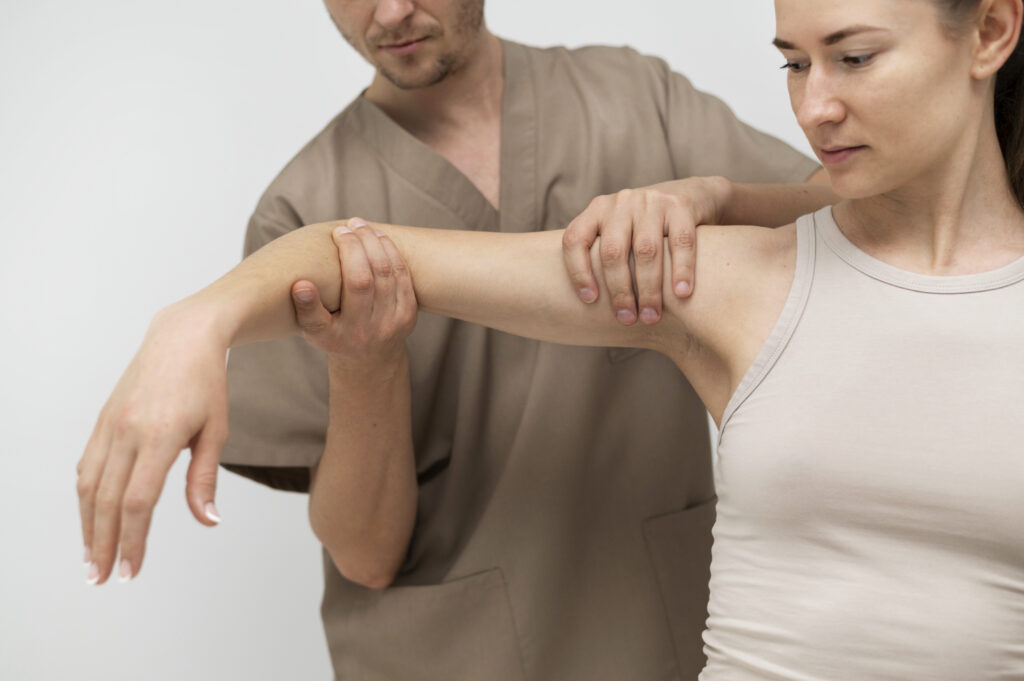If you're looking to enhance your joint flexibility and overall movement, there's a natural approach that can yield impressive results. By integrating specific stretching routines, targeted strength exercises, and mindful nutrition into your daily life, you could experience significant improvements. But it's not just about what you do; understanding how these elements work together is essential. You might be surprised at the simple changes that can make a big difference in your mobility and comfort. So, what's the first step you should take to kickstart this journey?
Understanding Joint Flexibility
Have you ever wondered why some people can easily touch their toes while others struggle? The answer lies in joint flexibility, which refers to the range of motion in your joints. This flexibility varies from person to person and is influenced by several factors, including genetics, age, and activity level.
When your joints are flexible, they can move freely without restrictions, allowing for a more fluid range of motion in your daily activities.
To understand joint flexibility, think about the connective tissues around your joints, including ligaments and tendons. These tissues play a significant role in determining how easily you can move. If they're tight or stiff, your range of motion will be limited.
Regular stretching and movement can help keep these tissues pliable and enhance your flexibility over time.
Another important aspect is the role of muscles. Muscles work in tandem with your joints, and tight muscles can restrict movement. Incorporating stretching routines into your daily life can effectively combat this tightness and improve your overall flexibility.
You don't need to be an athlete to benefit from improved joint flexibility; everyone can enhance their mobility through consistent practice.
Finally, don't underestimate the influence of hydration. Well-hydrated tissues can perform better, offering a more extensive range of motion.
Benefits of Improved Mobility
Improving your mobility can greatly enhance your physical performance, allowing you to move with greater ease and efficiency.
It also lowers your risk of injury, as flexible joints can handle stress better during activities.
Plus, better mobility contributes to improved posture alignment, which can lead to overall better health and comfort.
Enhanced Physical Performance
Enhanced mobility can greatly elevate your physical performance, allowing you to move more freely and efficiently. When your joints and muscles function at their best, you'll notice improvements in strength, speed, and endurance.
Whether you're an athlete or just enjoy staying active, enhanced mobility helps you execute movements with precision and power.
With increased flexibility, you can reach your full range of motion, enabling better execution of exercises and activities. This means you can lift heavier weights, jump higher, and run faster.
Improved mobility also allows you to perform complex movements that require coordination and balance, giving you an edge in sports and physical activities.
Furthermore, when you incorporate mobility training into your routine, you'll likely experience quicker recovery times. Your body will adapt more efficiently to physical stress, and you'll maintain peak performance levels.
This enhancement in mobility not only boosts your physical capabilities but also contributes to your overall confidence in movement.
Ultimately, improved mobility translates to better performance, allowing you to enjoy your favorite activities and achieve your fitness goals.
Embrace mobility training, and watch as your physical performance reaches new heights!
Reduced Injury Risk
One of the significant benefits of improved mobility is a reduced risk of injury. When your joints and muscles move freely, they can absorb impact better and respond appropriately to sudden movements. This flexibility helps you maintain proper form during physical activities, lowering the chances of strains or sprains.
By incorporating mobility exercises into your routine, you strengthen not just your muscles but also the connective tissues around your joints. Stronger tissues are less likely to suffer damage when faced with stress, whether from sports, daily tasks, or unexpected movements.
Additionally, improved mobility allows for better balance and coordination. When you can move fluidly, you're less likely to trip or fall, which is especially important as you age.
Regular mobility work can also address tight spots that might otherwise lead to compensation injuries. If one area of your body is stiff, others may overcompensate, leading to pain or injury over time.
Better Posture Alignment
Better mobility can greatly enhance your posture alignment, allowing your body to rest in its natural position. When your joints are flexible, you can move with greater ease, which directly impacts how you hold yourself throughout the day. This improved mobility helps you engage the right muscles, reducing strain on your back and neck.
As you practice movements that promote joint flexibility, you'll notice that standing, sitting, and even walking feel more effortless. You'll find it easier to maintain an upright position, which can alleviate discomfort and prevent long-term issues like chronic pain. Improved posture not only enhances your physical appearance but also boosts your confidence and overall well-being.
Additionally, better posture can improve your breathing, digestion, and circulation. When your spine is aligned correctly, your body functions more efficiently, allowing you to feel more energized and focused.
Effective Stretching Techniques
When it comes to improving your flexibility, understanding effective stretching techniques is key.
You'll find that dynamic stretching can warm up your muscles, while static stretching helps maintain flexibility.
Plus, incorporating PNF stretching can enhance your overall range of motion even further.
Dynamic Stretching Benefits
Dynamic stretching offers several benefits that can enhance your overall flexibility and performance. Unlike static stretching, dynamic stretches involve active movements that increase your heart rate and warm up your muscles, making them ideal for preparing your body for exercise.
You'll find that engaging in these stretches helps improve your range of motion, which is vital for peak performance in various physical activities. By incorporating dynamic stretching into your routine, you can also boost your athletic performance.
This method can enhance neuromuscular efficiency, allowing for smoother, quicker movements during your workouts or sports. You'll notice that dynamic stretches help activate the muscles you'll be using, reducing the risk of injury during high-intensity activities.
Additionally, dynamic stretching can increase blood flow to your muscles, ensuring they're ready to perform at their best. This increased circulation can also aid in faster recovery post-exercise.
As you regularly practice dynamic stretches, you'll likely observe an improvement in your overall coordination and balance, enhancing your ability to execute complex movements with ease.
Static Stretching Techniques
While dynamic stretching effectively warms up your muscles, incorporating static stretching techniques into your routine can further enhance flexibility and promote muscle recovery.
Static stretching involves holding a stretch for a period, usually 15 to 60 seconds, which helps lengthen your muscles and improve overall joint flexibility.
Here are three effective static stretching techniques you can try:
- Hamstring Stretch: Sit on the floor with one leg extended and the other bent. Reach for your toes on the extended leg while keeping your back straight. Hold this position to feel the stretch in your hamstring.
- Quadriceps Stretch: Stand on one leg and pull your other foot towards your buttocks. Keep your knees together and push your hips slightly forward. This stretch targets your quadriceps and helps with balance.
- Shoulder Stretch: Bring one arm across your body and use the other arm to gently pull it closer. This stretch effectively targets your shoulder muscles and can relieve tension.
PNF Stretching Explained
PNF stretching, or proprioceptive neuromuscular facilitation, is a highly effective technique for improving flexibility and increasing range of motion. This method involves both stretching and contracting the targeted muscle group, allowing you to push your limits safely.
You typically perform PNF stretching in pairs, where one partner assists you in achieving deeper stretches. To start, you'll stretch a muscle to its limit and hold it for about 10 seconds. Then, you'll contract that muscle for 5 to 10 seconds against resistance—this could be your partner gently pushing back.
After the contraction, you relax and immediately stretch the muscle again, often achieving a greater range than before. This cycle can be repeated several times.
It's essential to focus on controlled movements and proper breathing throughout the process. PNF stretching not only enhances flexibility but also improves neuromuscular coordination.
You may want to consult a fitness professional or physical therapist for guidance, especially if you're new to this technique. Incorporate PNF stretching into your routine, and you'll likely notice significant improvements in your joint flexibility and overall movement capabilities.
Strengthening Exercises for Joints
Strengthening your joints is vital for maintaining flexibility and preventing injury. By incorporating specific exercises into your routine, you can enhance joint stability and support overall mobility.
Here are three effective strengthening exercises that you can easily add to your weekly workout:
- Squats: Stand with your feet shoulder-width apart. Slowly lower your hips back as if sitting in a chair while keeping your chest up and knees aligned with your toes. Hold for a moment and return to standing. This exercise strengthens your knees, hips, and lower back, promoting joint stability.
- Lunges: Start in a standing position, then take a step forward with one foot, lowering your body until both knees are at about 90-degree angles. Push back to the starting position. Alternate legs. Lunges not only strengthen your legs but also engage your hip joints, enhancing their flexibility and endurance.
- Planks: Lie face down, then lift your body onto your forearms and toes, keeping your body in a straight line. Hold this position for as long as you can while maintaining form. Planks strengthen your core, which is vital for supporting your joints and maintaining proper alignment during other movements.
Incorporating these exercises into your fitness regimen can greatly improve joint strength and flexibility.
Remember to start with low repetitions and gradually increase as your strength improves. Always listen to your body to avoid overexertion.
Importance of Proper Nutrition
To support joint health and flexibility, proper nutrition plays a key role alongside your exercise routine. What you eat directly impacts your body's ability to recover and maintain healthy joints. Incorporating a balanced diet rich in essential nutrients will help you achieve ideal joint function and flexibility.
Start by focusing on anti-inflammatory foods. Leafy greens, fatty fish, nuts, and berries are excellent choices. Omega-3 fatty acids, found in fish like salmon and walnuts, help to reduce inflammation in your joints. Additionally, antioxidants from fruits and vegetables combat oxidative stress, which can contribute to joint pain and stiffness.
Don't forget about vitamins and minerals. Vitamin C, found in oranges and bell peppers, is necessary for collagen production, which supports cartilage health. Calcium and vitamin D work together to maintain bone density, reducing the risk of joint injuries. Incorporate dairy, fortified plant-based milks, or leafy greens to guarantee you're getting these essential nutrients.
Protein is another important component. It aids in repairing tissues and supporting muscle strength around your joints. Lean meats, legumes, and tofu provide the necessary building blocks for your body.
Lastly, healthy fats, such as those from olive oil and avocados, can also benefit your joints by reducing inflammation. By making these dietary changes, you'll not only support your joints but also enhance your overall physical performance.
Prioritizing proper nutrition is a simple yet powerful way to boost your joint flexibility and movement.
Staying Hydrated for Joint Health
Staying properly hydrated is crucial for maintaining joint health and flexibility, as water plays an important role in lubricating your joints and cushioning the cartilage.
When you're well-hydrated, your body can produce synovial fluid, which acts as a lubricant for your joints, reducing friction and helping them move smoothly. Without sufficient water intake, your joints can become stiff and painful, limiting your mobility.
To guarantee you're drinking enough water for ideal joint health, consider the following tips:
- Set a Daily Goal: Aim for at least eight 8-ounce glasses of water each day. Adjust this amount based on your activity level, climate, and individual needs.
- Incorporate Hydrating Foods: Include fruits and vegetables with high water content in your diet. Options like cucumbers, watermelon, and oranges can contribute considerably to your hydration levels.
- Listen to Your Body: Pay attention to signs of dehydration, such as dry mouth, fatigue, or dark-colored urine. If you notice these symptoms, increase your water intake immediately to support joint function.
Mindfulness and Relaxation Practices
Practicing mindfulness and relaxation techniques can greatly enhance your joint flexibility and overall movement. These practices help you become more aware of your body and its sensations, allowing you to identify areas of tension and stress. When you focus on being present and relaxed, you create a mental environment that promotes better physical performance.
Start by incorporating deep breathing exercises into your daily routine. Inhale deeply through your nose, hold for a few seconds, and exhale slowly through your mouth. This simple technique calms your mind and helps release tightness in your muscles and joints.
You might also want to try progressive muscle relaxation, where you systematically tense and then relax each muscle group. By doing this, you'll learn to recognize tension and how to let it go, improving your overall flexibility.
Meditation is another effective way to boost your mindfulness. Spend a few minutes each day sitting quietly and focusing on your breath or a specific thought. This practice can enhance your ability to concentrate and reduce stress, which, in turn, can positively impact your movement.
Lastly, consider incorporating gentle yoga or Tai Chi into your routine. These practices not only promote relaxation but also encourage fluid movement and flexibility.
Incorporating Movement Into Daily Life
Incorporating movement into your daily life can considerably enhance your joint flexibility and overall well-being. You don't need to commit to lengthy workouts; small adjustments can make a significant difference. By embracing movement in simple ways, you'll promote better joint health and boost your mood.
Here are three effective strategies to help you get started:
- Take the Stairs: Whenever possible, opt for stairs instead of elevators or escalators. Climbing stairs engages various muscle groups and encourages joint movement, enhancing flexibility over time.
- Active Breaks: Set a timer to remind yourself to take short breaks every hour. Use this time to stretch, walk around, or perform light exercises. Even five minutes of movement can reduce stiffness and improve circulation.
- Incorporate Movement into Chores: Turn mundane tasks like cleaning or gardening into opportunities for movement. Dance while you vacuum or practice lunges while tending to your plants. This approach not only makes chores enjoyable but also keeps your joints active.
When to Seek Professional Help
While integrating movement into your daily routine can greatly improve joint flexibility, there are times when professional guidance is necessary. If you experience persistent pain during movement, it's vital to consult a healthcare professional. Pain might indicate an underlying issue such as an injury or a chronic condition that needs proper evaluation. Ignoring these signals could lead to further complications.
Additionally, if you notice significant stiffness or reduced range of motion that doesn't improve with stretching or gentle exercises, seeking help is wise. A physical therapist or a qualified trainer can assess your condition and create a tailored program to address your specific needs. They can provide you with techniques to enhance flexibility while making sure you don't exacerbate any existing issues.
Don't hesitate to reach out if you have a history of joint problems or have recently undergone surgery. Professional guidance can help you safely regain your movement and strength.
Furthermore, if you're considering starting a new exercise regimen, consulting a professional can help you avoid injuries and guarantee you're using correct techniques.
Lastly, if you're unsure about the right exercises for your joints, professionals can guide you through safe and effective options. Remember, prioritizing your joint health is essential, and sometimes, the best path to improvement involves seeking help from those who specialize in movement and rehabilitation. Your body will thank you for it in the long run.
Conclusion
Improving your joint flexibility and movement naturally is all about consistency and balance. By incorporating stretching, strengthening exercises, proper nutrition, and mindfulness into your daily routine, you can enhance your mobility and overall well-being. Remember to stay hydrated and listen to your body's needs. If you ever feel unsure or experience persistent discomfort, don't hesitate to seek professional guidance. Embrace these practices, and you'll find yourself moving more freely and enjoying life to the fullest.



